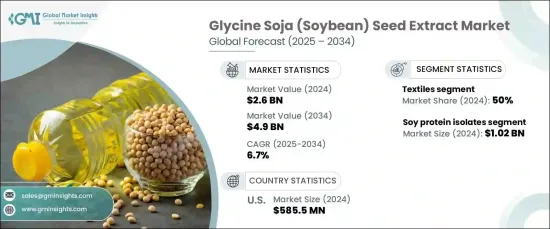
세계의 돌콩(대두) 종자 추출물 시장은 2024년에 26억 달러로 평가되었고 2025년부터 2034년에 걸쳐 CAGR 6.7%의 강력한 성장률을 이룰 전망입니다.
대두에서 유래하는 돌콩 종자는 피부 관리 및 화장품 산업의 강력한 성분이며 피부에 수분을 공급하고 항산화 보호를 제공하는 능력으로 탁월합니다. 세계 산업계가 지속가능하고 고성능 솔루션을 계속 선호하는 가운데 대두 유래 추출물 시장은 이러한 수요에 부응하기 위해 진화하고 있습니다. 천연적이고 친환경적인 제품을 요구하는 소비자의 선호를 받아 각 회사는 엄격한 환경 규제를 준수하면서 보다 효율적인 제제를 혁신적으로 개발하고 있습니다. 이와 같은 진보로 돌콩 종자 추출물 시장은 경쟁이 치열하고 빠르게 변화하는 세계 상황에서 장기적인 성공을 거두고 있습니다.

시장은 대두 이소플라본, 분리 대두 단백질, 대두 레시틴, 사포닌, 대두 인지질 등 제품 유형별로 구분됩니다. 2024년에는 분리 대두 단백질이 주도권을 잡고 10억 2,000만 달러의 상당한 시장 점유율을 기록했습니다. 이러한 대두 기반 제품에 대한 수요는 최근 급증하고 있으며, 그 주된 이유는 여러 산업에 걸친 다목적 용도 때문입니다. 대두 레시틴은 탁월한 유화 특성으로 인해 식품 제조 및 의약품에 널리 사용됩니다. 한편, 대두 인지질은 그 다기능성이 평가되고, 화장품 제제나 영양 보조 식품에서의 사용이 증가하고 있어 시장의 성장을 더욱 촉진하고 있습니다.
| 시장 범위 | |
|---|---|
| 시작 연도 | 2024년 |
| 예측 연도 | 2025-2034년 |
| 시작 금액 | 26억 달러 |
| 예측 금액 | 49억 달러 |
| CAGR | 6.7% |
용도별로 돌콩(대두) 종자 추출물 시장은 화장품 및 퍼스널케어, 식품 및 음료, 영양 보조 식품, 의약품, 사료 등의 주요 분야로 나눌 수 있습니다. 2023년에 50%의 점유율을 차지한 섬유 산업은 여전히 시장의 지배적인 분야입니다. 건강과 웰빙에 대한 소비자의 관심이 높아짐에 따라, 영양보조식품, 영양보조식품, 퍼스널케어 아이템에 있어서의 대두 유래 제품의 채용을 가속화하고 있습니다. 단백질, 오메가 3 지방산, 이소 플라본과 같은 주요 대두 성분은 많은 건강상의 이점으로부터 인기가 높아지고 있으며,이 분야에서의 확대를 견인하고 있습니다.
2024년에는 미국의 돌콩 종자 추출물 시장이 특히 호조로 5억 8,550만 달러를 창출했습니다. 이 나라 시장 성장은 건강 지향 소비자가 보다 깨끗하고 투명한 선택을 요구하게 되고, 자연스럽고 지속 가능한 제품에 대한 수요가 높아지고 있는 것이 배경에 있습니다. 콩은 식품, 화장품 및 의약품을 포함한 다양한 분야에 적응할 수 있기 때문에 시장에서의 지속적인 관련성이 보장되고 미국이 세계 시장에서 주도적인 지위를 더욱 견고하게 하고 있습니다.
The Global Glycine Soja (Soybean) Seed Extract Market, with an estimated value of USD 2.6 billion in 2024, is set to experience a robust growth rate of 6.7% CAGR from 2025 to 2034. Derived from soybeans, glycine soja seed extract is a powerhouse ingredient in the skincare and cosmetics industries, prized for its ability to hydrate the skin and provide antioxidant protection. As global industries continue to prioritize sustainable and high-performance solutions, the market for soybean-based extracts is evolving to meet these demands. In response to consumer preferences for natural and eco-friendly products, companies are innovating and developing more efficient formulations while adhering to strict environmental regulations. These advancements position the glycine soja seed extract market for long-term success in a competitive, rapidly changing global landscape.

The market is segmented by product type, including soy isoflavones, soy protein isolates, soy lecithin, saponins, and soybean phospholipids. In 2024, soy protein isolates lead the charge, capturing a substantial market share worth USD 1.02 billion. The demand for these soy-based products has surged in recent years, largely due to their versatile applications across multiple industries. Soy lecithin is widely used in food production and pharmaceuticals due to its exceptional emulsifying properties while soybean phospholipids, valued for their multifunctionality, have seen increased use in cosmetic formulations and dietary supplements, further fueling market growth.
| Market Scope | |
|---|---|
| Start Year | 2024 |
| Forecast Year | 2025-2034 |
| Start Value | $2.6 Billion |
| Forecast Value | $4.9 Billion |
| CAGR | 6.7% |
In terms of application, the glycine soja (soybean) seed extract market is divided into key sectors such as cosmetics and personal care, food and beverages, nutraceuticals and dietary supplements, pharmaceuticals, and animal feed. The textiles industry, which held a 50% share in 2023, remains a dominant player in the market. Consumers' growing interest in health and wellness has accelerated the adoption of soy-derived products in nutraceuticals, dietary supplements, and personal care items. Key soy ingredients like protein, omega-3 fatty acids, and isoflavones are becoming more popular for their numerous health benefits, driving expansion across these sectors.
The U.S. glycine soja seed extract market is particularly strong, generating USD 585.5 million in 2024. The nation's market growth is fueled by the increasing demand for natural, sustainable products as health-conscious consumers seek cleaner, more transparent options. Soy's adaptability across various sectors, including food, cosmetics, and pharmaceuticals, ensures its continued relevance in the market, further solidifying the U.S.'s leading position in the global market.